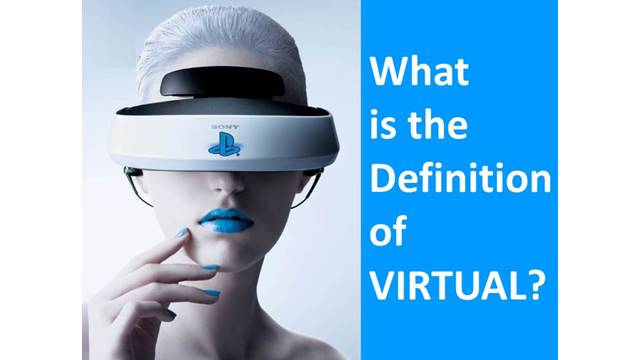

Virtual computing also improves the speed, accessibility and performance of IT operations and users. It also frees up space on individual devices because users don't have to install, configure or store the assets they need as they can be accessed remotely and on-demand. Allocating a computer's processes and resources to a virtual environment makes the system available for other processes and applications, which increases the overall efficiency of the system. Virtual computing helps expand the enterprise IT environment to users who are not in the same location as the resources they need to access. Managers can access documents or data remotely.

#VIRTUAL MEANING HOW TO#
More practical use cases for VR include training employees for presentations, learning how to operate a crane, drive a truck, deal with difficult customers and much more. Games in VR have proven very popular as the immersion completely teleports the player to a different world. Currently you can play a wide range of games from table tennis, to mountain climbing, to zombie shooting. You can watch these videos from your computer, using your mouse to scroll around the 360 environment, or in a VR headset, where you can move your head and look around the 360 degree video.Ī very common use case for VR is gaming. There are some great examples on YouTube of this, where you can explore remote caves, take a ride on a roller-coaster, explore Victoria Falls and much more. The simplest example is watching a 360 degree movie, which appears all around you as you watch it. There are currently many uses of VR across a wide range of industries. Explore Courses Virtual reality use cases Since then, there have been many improvements to VR technology, leading to the launch of the Oculus Rift in 2012, which kickstarted VR as we know it today.įast-track your career with award-winning courses and realistic practice. However in 1935, VR became more commonplace, appearing in Pygmalion's Spectacles - a science fiction story where the main character wears a pair of goggles which transports him to a fictional world. The first technical developments for virtual reality were in the 1830s. This illusion can be very powerful after spending just a few minutes in VR, and can lead to scenarios such as people walking into walls because they forgot they are in a virtual world. These simulated graphics, combined with sound from the VR headset, trick our brain into believing that we are actually in the virtual world.

As you look around with the VR headset over your eyes, the virtual world moves as it would in the real world.
#VIRTUAL MEANING SOFTWARE#
Software creates the virtual worlds that are seen and experienced by users who wear a VR headset. Interactive: You can interact with different objects in the scene, whether it’s pressing a button or opening a door.Īugmented reality (AR) is different from VR as it enhances your real world view with digital overlays, whereas VR is a fully immersive experience in which you can’t see the real world.Computer-generated: VR worlds are usually created with complex 3D computer graphics that change in real time as we move.Fully immersive: As you move your head around with the VR headset on, what you see changes as well, just as it would in real life.Believable: You feel like you're in the virtual world through what you see and hear.Virtual reality usually has these 4 characteristics:


 0 kommentar(er)
0 kommentar(er)
